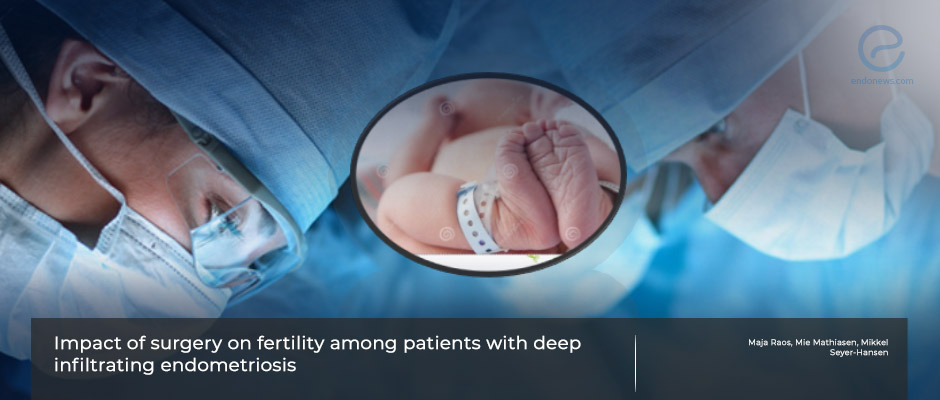Postoperative pregnancy outcomes in women with deep infiltrating endometriosis
Mar 22, 2023
Surgery for rectosigmoid endometriosis has no significant difference on postoperative pregnancy and live birth rates compared to conservative treatment.
Key Points
Highlights:
- Surgery for deep infiltrating endometriosis is feasible and effective and in terms of pregnancy rates, the results are compatible with conservative treatment.
Importance:
- The women with deep infiltrating endometriosis who will undergo surgical excision should be informed about postoperative pregnancy and live birth rates.
What’s done here?
- This case-series study was conducted to clarify the effect of the surgical approach on pregnancy outcomes in women having deep infiltrating endometriosis.
- Pregnancy rate and live birth rate were considered as primary outcomes while secondary outcomes were time to pregnancy, postoperative complications, and the presence of stoma.
- Only ongoing pregnancy by positive pregnancy test or live fetus in gestational week six to eight on ultrasound examination was accepted as pregnancy.
- Rectosigmoid segment or disc resection, depending on the size and accessibility of the infiltration, was performed during the operation by the gynecologist and general surgeon experienced in minimally invasive gynecology.
- Pain and fertility status was reviewed at the outpatient clinic or by phone at four months, one, and two years after surgery.
- Demographic and clinical characteristics including previous surgery, perioperative surgical information, complications, hospitalization time, magnetic resonance imaging (MRI) information on the extent of the bowel infiltrate and other locations of endometriosis as well as pre-and postoperative pregnancy and fertility were obtained from hospital records.
4. Key results:
- A total of 193 women who underwent deep infiltrating endometriosis surgery was included in this study.
- Segmental resection and disc excision were performed in 149 patients (77.2%) and 44 patients (22.8%), respectively.
- Women having preoperative primary infertility (n=148) had postoperative pregnancy rate of 64.9% with 34.4% as spontaneous pregnancies whereas women with secondary infertility preoperatively had postoperative pregnancy rate of 46.7% with 28.6% as spontaneous pregnancies.
- Live birth rate was estimated as 53.9% (104/193) and most of them (61.5%) became pregnant following assisted reproduction technology (ART) treatment.
- Median time to spontaneous pregnancy was found to be 9.8 months and 12.6 months for ART pregnancies.
- A total of 38 patients (19.7%) had postoperative complications such as anastomotic leakage, ureteral leakage, pelvic abscess, rectovaginal fistula, ureteral obstruction, ureterovaginal fistula and bladder perforation.
- Time to pregnancy and live birth rate were not affected by the presence of complications.
5. Strengths and Limitations
- The strength of the study is that it is the study investigating the pregnancy outcomes in a large sample size at a single specialized center.
- The limitations of the study are that it cannot be generalized due to its application in a single center, in addition to its retrospective design.
- Lack of information on pain and other endometriosis-associated symptoms and smoking and alcohol consumption could be accepted as other limitations.
Lay Summary
Subperitoneal invasion of endometriotic lesions exceeding 5 mm in depth is named "deep infiltrating endometriosis' and can be located on uterosacral ligaments, in the intestine, vagina, bladder, and ureter. Women with deep infiltrating endometriosis suffer from pelvic pain and infertility most commonly and demand treatment to increase the quality of their life.
Although management is individualized depending on the patient’s symptoms and pregnancy wish, the first-line treatment is hormonal therapy, especially in women with pelvic pain. However, medical treatment has no place for patients with pregnancy intentions due to their contraceptive effect. Surgical excision is frequently preferred as the management method in patients with deep infiltrating endometriosis.
Raos et al, from Denmark, published a study titled “Impact of surgery on fertility among patients with deep infiltrating endometriosis” in the journal European Journal of Obstetrics & Gynecology and Reproductive Biology. The authors sought to investigate the pregnancy and live birth rate following segmental resection and disc excision due to deep infiltrating endometriosis. They also evaluated the effect of surgical complications on pregnancy outcomes.
Women having preoperative primary infertility had postoperative pregnancy rates of 64.9% with 34.4% as spontaneous pregnancies whereas women with secondary infertility preoperatively had postoperative pregnancy rates of 46.7% with 28.6% as spontaneous pregnancies. The live birth rate was estimated as 53.9% and most of them (61.5%) became pregnant following assisted reproduction technology (ART) treatment. Postoperative complications such as anastomotic leakage, ureteral leakage, pelvic abscess, rectovaginal fistula, ureteral obstruction, ureterovaginal fistula, and bladder perforation were experienced in 38 patients (19.7%). Time to pregnancy and live birth rate were not affected by the presence of complications.
“Patients suffering from bowel endometriosis should not stay away from surgery because of fear of complications affecting their chances of pregnancy.” the authors added.
Research Source: https://pubmed.ncbi.nlm.nih.gov/36508855/
endometriosis deep infiltrating endometriosis bowel endometriosis colorectal resection pregnancy rate assisted reproductive technologies

